Sarah Sundin's Blog, page 147
January 13, 2022
Today in World War II History—January 13, 1942

Posters for the US Army Air Forces and the Royal Air Force, WWII
80 Years Ago—Jan. 13, 1942: First use of an ejection seat—by German test pilot Helmut Schenk in a Heinkel He 280 jet.
The Arnold-Portal agreement specifies the number of aircraft the US will provide to Britain, while building the US Army Air Forces to a goal of 115 groups.
The post Today in World War II History—January 13, 1942 first appeared on .January 12, 2022
Books in World War II
 Books in World War II
Books in World War IIBooks and reading played a vital and surprising role in World War II in the United States, involving civilians in the war effort, increasing morale in the military, and spreading democratic values at home and abroad.
When the United States entered World War II in 1941, the average American soldier had an eleventh-grade education and didn’t read for pleasure. Hardback books cost $2, which were expensive considering the average yearly wages of about $2000.
Pocket Books had begun publishing the first mass market paperback books in the United States in July 1939 for only 25¢, but as of 1939, fewer than 200,000 paperbacks were published each year.

“Soldiers at Camp Robinson, Arkansas, trying to get books from the Service Club Library. Although the library has 5000 books, it is badly in need of more. The average circulation runs about 200 to 300 books per day, with a record of 525 in one day. Miss Maurine Doores is the librarian.” January 22, 1942. (Signal Corps Photo #162-42-79 by Weber, 162nd Signal Photographic Company.)
Book Burnings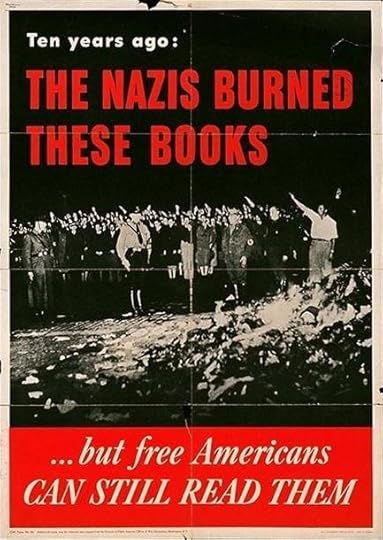
US poster, 1943
When the Nazis came to power in Germany in 1933, massive book burnings were held, destroying millions of books by authors who were Jewish, who spoke out against the Nazis, or who had opposing political ideas. And as the Nazis conquered other countries, they burned and confiscated books as well. In all, the Nazis are believed to have destroyed 100 million books.
This censorship and destruction struck deep at the heart of those in the western democracies and reminded them that books and ideas were vital to freedom.
Servicemen Need Books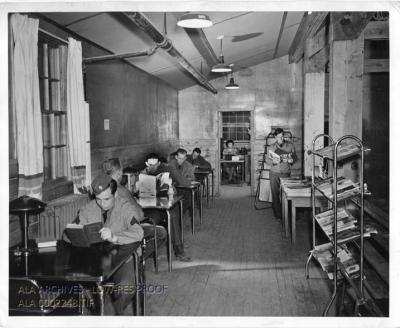
Soldiers Reading at Camp Forrest Library, Tullahoma, TN, 13 Feb 1942 (US Army Signal Corps)
Boredom kills morale, so the US armed forces provided libraries at training camps and bases. Servicemen were often too exhausted from a day of training to engage in sports, so many frequented the libraries and discovered the joy of a good book.
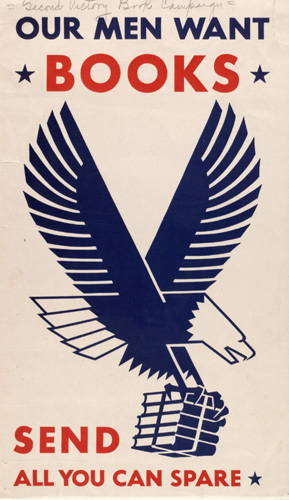
Poster from the US Victory Book Campaign, 1942-43
The US Army wanted to have one book per enlisted man. But when the US instituted the peacetime draft in 1940, men flooded the training camps – and their libraries. Local communities held drives to supply the libraries, but it wasn’t enough.
Victory Book Campaign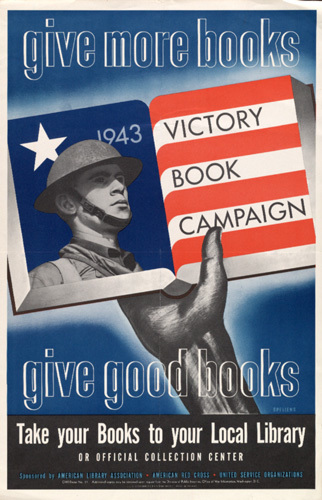
Poster for the US Victory Book Campaign, 1943
Responding to this need, the American Library Association, working with the USO and the American Red Cross, founded the National Defense Book Campaign on November 8, 1941. The following month, after Pearl Harbor, the name was changed to the Victory Book Campaign.

American Red Cross volunteers collect books for the Victory Book Campaign in World War II (US Army Center of Military History)
The first book drive started January 12, 1942 with the goal of collecting 10 million books in one month. Throughout the nation, people were urged to donate used books for the soldiers. Various groups collected the books, including the Red Cross, Boy Scouts, and Girl Scouts. A series of rallies were held at the New York Public Library, and publicity spread throughout the nation with posters and collection bins. Local libraries sorted the books, which were then sent to Army and Navy camps.
Despite the promotion, only about 1 million books were collected. President Franklin D. Roosevelt declared April 17, 1942 “Victory Book Day” to push closer to that 10 million book quota, and universities were encouraged to hold book drives with their graduation ceremonies. By June 1942, the 10 million-book goal was met–but it wasn’t enough.
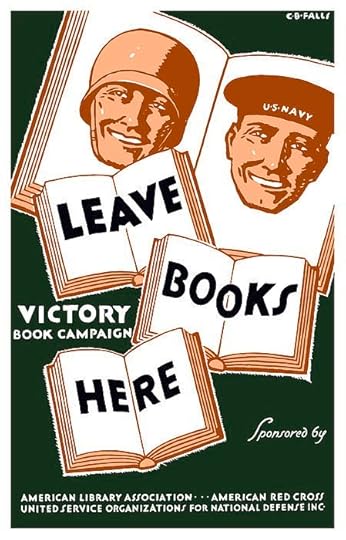
Poster for the US Victory Book Campaign, 1942-43
While well intentioned, the program had some problems. First, about one-third of the donated books were unusable—worn-out books, children’s books, or titles of little interest to young men. Second, the typical hardback book was heavy and large. Shipping was expensive and used valuable cargo space needed for war materiel, and the books were too unwieldy for the men to carry into combat. Third, by 1943, donations dropped even further as the supply of excess books decreased.

Poster for the US Victory Book Campaign, 1943 (US National Archives 514404)
In May 1943, the Army and Navy declared Victory Book Campaign books were no longer needed, and the program was shut down on December 31, 1943. Still, the campaign had collected 18 million books, 11 million of which were distributed.
Armed Services Editions
Armed Services Edition of The Great Gatsby by F. Scott Fitzgerald, in Library of Congress Rare Books and Special Collections Division (Library of Congress, photo by Shawn Miller)
In March 1942, the Council on Books in Wartime was founded by 70 representatives of publishing houses. Starting in November 1942, the council’s War Book Panel promoted “Imperative” books for the nation to read together, books which promoted American ideals.
Working with the armed services, they came up with an ingenious—and generous—plan. In July 1943, the Council of Books in Wartime signed a contract with the US military to produce special Armed Services Editions. Publishers allowed their books to be published in these editions, accepting only 1¢ royalty per volume, to be split between the publisher and the author.
The Armed Services Editions were printed on thin paper with small font, in a size small enough to fit into a uniform trouser pocket. These thin paperbacks were designed to be passed around between servicemen and eventually discarded.

Armed Services Edition of The Story of George Gershwin by David Ewen, in Library of Congress Rare Books and Special Collections Division (Library of Congress, photo by Shawn Miller)
The Council chose titles in a variety of genres—“dime store” cowboy and detective novels, high literature, history, biography, poetry, humor, and more. The concept was to entertain and to educate, and the Council didn’t shy away from controversial titles—although they didn’t publish any that might give “comfort to the enemy.”
Starting in September 1943, thirty Armed Service Edition titles were published each month, with 50,000 copies of each title. Both the quantity of titles and the print runs increased during the war due to high demand. The peak was reached in July 1945, when 155,000 copies each of 40 titles were distributed.
In addition, US Overseas Editions books were also published – the Armed Services Editions books translated into French, Italian, and other languages for distribution in recently liberated nations. In total, 3.2 million copies of 72 titles would be shipped to Europe.
An Army of Readers
Servicemen bound for Guadalcanal grab books as they board. (U.S. Navy)
Men carried the Armed Services Editions into battle, from Omaha Beach to Iwo Jima to Okinawa. They read them to their buddies in their ship’s hammocks. They read by the light of artillery shells at night.
The men found books inspired them, reminding them of why they fought. Books distracted them from the horrors and rigors and boredom of military life. And books taught them new things and opened new doors and windows.
By the time the Armed Services Editions program ended in 1947, 123 million books had been published.
A Nation of Readers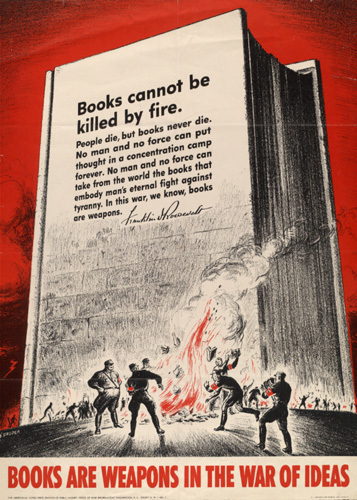
US poster, WWII
There was a severe paper shortage in the US from 1943-45 (See “Scrap Drives in World War II”). The publishing industry was restricted to 37.5% of the paper they’d used in 1939. Even so, the number of books published actually increased during the war due to the rise of paperbacks. By 1943, over 40 million paperbacks were being published per year on the Home Front!
With the Victory Book Campaign and the Armed Services Editions and inexpensive paperbacks, a new generation of readers had been created. Servicemen who’d never considered themselves readers had found that they could read history and poetry—and like it. Books were no longer only for the rich, but for everyone, democracy in action.
After the war, many of the soldiers and sailors and airmen went to college on the GI Bill, inspired and encouraged by the books they’d read—and by realizing they did in fact enjoy reading.
The Council of Books in Wartime’s motto was “Books are weapons in the war of ideas.” This was proven correct. In the end, generosity and freedom triumphed over destruction and censorship, and the whole world benefited.
Resources:Manning, Molly Guptill. When Books Went to War. New York: Mariner Books, 2014.
Appelbaum, Yoni. “Publishers Gave Away 122,951,031 Books During World War II.” The Atlantic, 10 September 1941. Accessed 5 March 2020.
Allen, Erin. “Books in Action: The Armed Services Editions.” Library of Congress blog, 30 September 2015. Accessed 5 March 2020.
Brozyna, Andrew. “The Victory Book Campaign.” On the Books for Victory website, 11 June 2012. Accessed 12 June 2012. (Site no longer active).
The post Books in World War II first appeared on .Today in World War II History—January 12, 1942

U-123 preparing to fire on a surface vessel off the US East Coast, Jan-Feb 1942 (German Federal Archive, Bild 101II-MW-4008-20)
80 Years Ago—Jan. 12, 1942: Off Nova Scotia, German U-boat U-123 sinks British freighter Cyclops, the first loss in Germany’s “Operation Paukenschlag.”
Col. Charles Lindbergh is refused a military command due to his vocal pre-war isolationist work.
US forms National War Labor Board to deal with union wage demands.
In US, the Victory Book Campaign begins, with a goal to collect 10 million books for servicemen in 1 month (Read more: “Books in World War II”).

Poster for the US Victory Book Campaign, 1942-43
The post Today in World War II History—January 12, 1942 first appeared on .January 11, 2022
Pre-Order Until Leaves Fall in Paris and Receive Goodies!

Until Leaves Fall in Paris is coming February 1, 2022! My publisher, Revell Books, and I have put together a fun package of goodies for anyone who pre-orders a copy (or has already done so) and enters by January 30, 2022!
You can pre-order at your local bookstore or online (find links here). Any version counts, including e-books! Baker Book House has an amazing pre-order deal (40% off, plus free shipping)!
As my thanks to you for pre-ordering Until Leaves Fall in Paris, you will receive:
An easy Eiffel Tower origami project!A sneak peek at chapter one of the story!Laptop and phone screensavers with artwork from the book!A signed customized bookplate – designed like Lucie’s bookplates from Green Leaf Books, Paris!Until Leaves Fall in Paris bookmarks and postcards
To receive your goodies, pre-order your copy of Until Leaves Fall in Paris—or find your confirmation number if you’ve already done so! Then fill out this Google Form. If you filled out the form earlier, no need to do so again—you should already have an email in your inbox from me. If not, please contact me.
Note: Due to high postage costs, I reserve the right to limit quantities of bookmarks & postcards mailed to addresses outside the US.
Offer ends January 30, 2022, so don’t wait! By pre-ordering, you’ll receive the book first—and you create interest in bookstores that helps the book succeed.
Also, please join me on Facebook Live Video on my author page January 11, 2022 at 11 am Pacific Time/ 2 pm Eastern – I’ll share about each of the items! The video will be available for viewing later too.
While you’re here, enjoy this beautiful trailer Revell Books made for the novel!
The post Pre-Order Until Leaves Fall in Paris and Receive Goodies! first appeared on .Today in World War II History—January 11, 1942

Japanese troops in Kuala Lumpur, Malaya, 11 Jan 1942 (Imperial War Museum: 5707-03 HU 2776)
80 Years Ago—Jan. 11, 1942: Japanese invade the Netherlands East Indies, landing at Tarakan, Borneo, and in Celebes.
Japanese take Kuala Lumpur, Malaya.
Operation Paukenschlag (“roll of the kettledrums”) is set to begin: first group of 5 German U-boats (U-66, U-109, U-123, U-125, U-130) takes up station off the US East Coast; will sink 26 ships in a month.
The post Today in World War II History—January 11, 1942 first appeared on .January 10, 2022
Today in World War II History—January 10, 1942
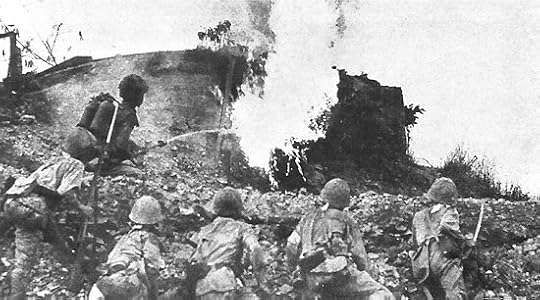
Japanese flamethrower on the Orion-Bagac Line, Bataan Peninsula, 1942 (public domain, Japanese government photo)
80 Years Ago—Jan. 10, 1942: Japanese make first surrender demand to US forces on the Bataan Peninsula in the Philippines.
Ford Motor Company signs a contract to manufacture jeeps for the US Army.
Actor Mickey Rooney (age 21) marries actress Ava Gardner (age 19); they divorce in 1943.
The post Today in World War II History—January 10, 1942 first appeared on .January 9, 2022
Today in World War II History—January 9, 1942

British Royal Engineers preparing to blow up a bridge in Malaya during the retreat to Singapore, Dec 1941 (Imperial War Museum: 4700-45 KF 89)
80 Years Ago—Jan. 9, 1942: Soviets begin offensive at Moscow and Smolensk (Battle of the Valdai Hills).
In Malaya, British begin withdrawal into Johore to protect Singapore.
The post Today in World War II History—January 9, 1942 first appeared on .January 8, 2022
Today in World War II History—January 8, 1942
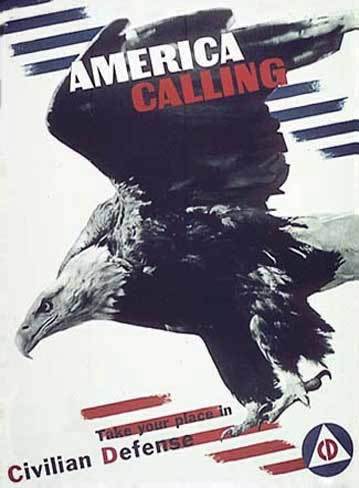
Poster for the US Office of Civilian Defense, WWII
80 Years Ago—Jan. 8, 1942: US Army Forces in British Isles (USAFBI) is established under Maj. Gen. James Chaney.
Japanese take Jesselton, capital of British North Borneo.
James Landis is named to succeed Mayor Fiorello LaGuardia as head of the US Office of Civil Defense.
The post Today in World War II History—January 8, 1942 first appeared on .January 7, 2022
Today in World War II History—January 7, 1942
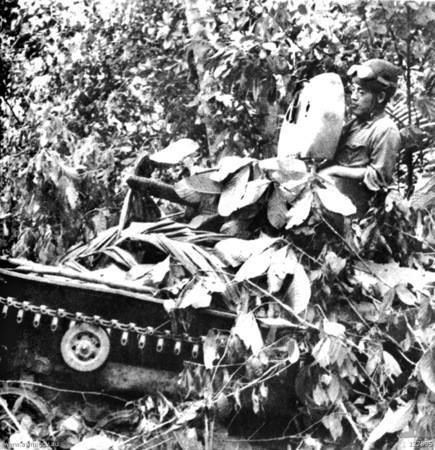
Japanese tankette during Battle of Muar, Malaya, mid-Jan 1942 (public domain via WW2 Database)
80 Years Ago—Jan. 7, 1942: In the Philippines, Japanese begin siege of the Bataan Peninsula.
In Malaya, Japanese break through Indian defenses at the Slim River.
US Navy issues a warning that 16 German U-boats are suspected to be near the US East Coast.
The post Today in World War II History—January 7, 1942 first appeared on .January 6, 2022
Today in World War II History—January 6, 1942

Combined Chiefs of Staff in Québec, Canada, August 23, 1943 (US government photo)
80 Years Ago—Jan. 6, 1942: Roosevelt’s State of the Union address calls for the production of 60,000 aircraft and 1.2 million tons of shipping in 1942.
Combined Chiefs of Staff (CCS) is formed, consisting of the British Chiefs of Staff & US Joint Chiefs of Staff.
Pan Am’s Pacific Clipper lands in New York City, the first commercial airplane to circumnavigate the globe, having left San Francisco for New Zealand Dec. 2, 1941, being stranded after Pearl Harbor, and forced to head west rather than back east.
The post Today in World War II History—January 6, 1942 first appeared on .


